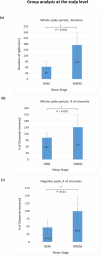Quantitative spatio-temporal characterization of epileptic spikes using high density EEG: Differences between NREM sleep and REM sleep
- PMID: 32015406
- PMCID: PMC6997449
- DOI: 10.1038/s41598-020-58612-4
Quantitative spatio-temporal characterization of epileptic spikes using high density EEG: Differences between NREM sleep and REM sleep
Abstract
In this study, we applied high-density EEG recordings (HD-EEG) to quantitatively characterize the fine-grained spatiotemporal distribution of inter-ictal epileptiform discharges (IEDs) across different sleep stages. We quantified differences in spatial extent and duration of IEDs at the scalp and cortical levels using HD-EEG source-localization, during non-rapid eye movement (NREM) sleep and rapid eye movement (REM) sleep, in six medication-refractory focal epilepsy patients during epilepsy monitoring unit admission. Statistical analyses were performed at single subject level and group level across different sleep stages for duration and distribution of IEDs. Tests were corrected for multiple comparisons across all channels and time points. Compared to NREM sleep, IEDs during REM sleep were of significantly shorter duration and spatially more restricted. Compared to NREM sleep, IEDs location in REM sleep also showed a higher concordance with electrographic ictal onset zone from scalp EEG recording. This study supports the localizing value of REM IEDs over NREM IEDs and suggests that HD-EEG may be of clinical utility in epilepsy surgery work-up.
Conflict of interest statement
The authors declare no competing interests.
Figures




Similar articles
-
The value of rapid eye movement sleep in the localization of epileptogenic foci for patients with focal epilepsy.Seizure. 2020 Oct;81:192-197. doi: 10.1016/j.seizure.2020.06.009. Epub 2020 Jul 14. Seizure. 2020. PMID: 32854037
-
Rapid eye movement sleep affects interictal epileptic activity differently in mesiotemporal and neocortical areas.Epilepsia. 2023 Nov;64(11):3036-3048. doi: 10.1111/epi.17763. Epub 2023 Sep 30. Epilepsia. 2023. PMID: 37714213
-
EEG desynchronization during phasic REM sleep suppresses interictal epileptic activity in humans.Epilepsia. 2016 Jun;57(6):879-88. doi: 10.1111/epi.13389. Epub 2016 Apr 25. Epilepsia. 2016. PMID: 27112123 Free PMC article.
-
Sleep EEG synchronization mechanisms and activation of interictal epileptic spikes.Clin Neurophysiol. 2000 Sep;111 Suppl 2:S65-73. doi: 10.1016/s1388-2457(00)00404-1. Clin Neurophysiol. 2000. PMID: 10996557 Review.
-
Sleep and arousal mechanisms in experimental epilepsy: epileptic components of NREM and antiepileptic components of REM sleep.Ment Retard Dev Disabil Res Rev. 2004;10(2):117-21. doi: 10.1002/mrdd.20022. Ment Retard Dev Disabil Res Rev. 2004. PMID: 15362167 Review.
Cited by
-
Can REM Sleep Localize the Epileptogenic Zone? A Systematic Review and Analysis.Front Neurol. 2020 Jul 24;11:584. doi: 10.3389/fneur.2020.00584. eCollection 2020. Front Neurol. 2020. PMID: 32793089 Free PMC article.
-
Dreams interrupted: characteristics of REM sleep-associated seizures and status epilepticus.J Clin Sleep Med. 2025 Jan 1;21(1):23-32. doi: 10.5664/jcsm.11336. J Clin Sleep Med. 2025. PMID: 39167425
-
Timing Mechanisms for Circadian Seizures.Clocks Sleep. 2024 Oct 21;6(4):589-601. doi: 10.3390/clockssleep6040040. Clocks Sleep. 2024. PMID: 39449314 Free PMC article. Review.
-
Consistency of electrical source imaging in presurgical evaluation of epilepsy across different vigilance states.Ann Clin Transl Neurol. 2024 Feb;11(2):389-403. doi: 10.1002/acn3.51959. Epub 2024 Jan 12. Ann Clin Transl Neurol. 2024. PMID: 38217279 Free PMC article.
-
Sleep-wake states change the interictal localization of candidate epileptic source generators.Sleep. 2022 Jun 13;45(6):zsac062. doi: 10.1093/sleep/zsac062. Sleep. 2022. PMID: 35279715 Free PMC article.

